Nursing Care for COPD Patient
VerifiedAdded on 2020/02/24
|9
|2114
|107
AI Summary
The assignment presents a case study of a patient named Jim diagnosed with Chronic Obstructive Pulmonary Disease (COPD). It requires the analysis of five potential health issues associated with his condition, ranking them based on priority. The assignment emphasizes the importance of patient-centered care and highlights the nurse's role in addressing Jim's needs through interventions such as balanced diet, activity management, and emotional support from family and community.
Contribute Materials
Your contribution can guide someone’s learning journey. Share your
documents today.

Running Head: Integrated nursing practice
Integrated nursing practice
Name of the Student
Name of the University
Author Note
Integrated nursing practice
Name of the Student
Name of the University
Author Note
Secure Best Marks with AI Grader
Need help grading? Try our AI Grader for instant feedback on your assignments.
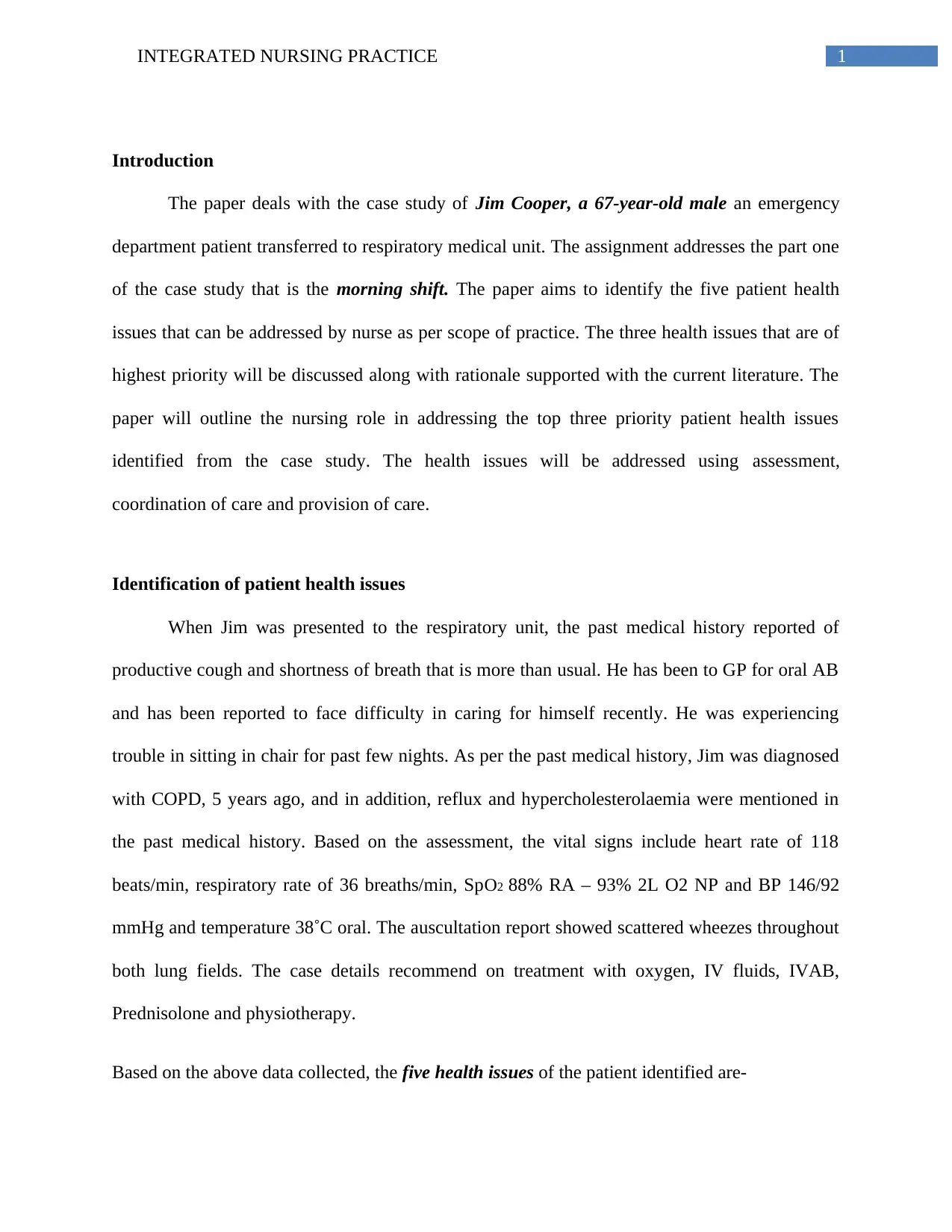
1INTEGRATED NURSING PRACTICE
Introduction
The paper deals with the case study of Jim Cooper, a 67-year-old male an emergency
department patient transferred to respiratory medical unit. The assignment addresses the part one
of the case study that is the morning shift. The paper aims to identify the five patient health
issues that can be addressed by nurse as per scope of practice. The three health issues that are of
highest priority will be discussed along with rationale supported with the current literature. The
paper will outline the nursing role in addressing the top three priority patient health issues
identified from the case study. The health issues will be addressed using assessment,
coordination of care and provision of care.
Identification of patient health issues
When Jim was presented to the respiratory unit, the past medical history reported of
productive cough and shortness of breath that is more than usual. He has been to GP for oral AB
and has been reported to face difficulty in caring for himself recently. He was experiencing
trouble in sitting in chair for past few nights. As per the past medical history, Jim was diagnosed
with COPD, 5 years ago, and in addition, reflux and hypercholesterolaemia were mentioned in
the past medical history. Based on the assessment, the vital signs include heart rate of 118
beats/min, respiratory rate of 36 breaths/min, SpO2 88% RA – 93% 2L O2 NP and BP 146/92
mmHg and temperature 38˚C oral. The auscultation report showed scattered wheezes throughout
both lung fields. The case details recommend on treatment with oxygen, IV fluids, IVAB,
Prednisolone and physiotherapy.
Based on the above data collected, the five health issues of the patient identified are-
Introduction
The paper deals with the case study of Jim Cooper, a 67-year-old male an emergency
department patient transferred to respiratory medical unit. The assignment addresses the part one
of the case study that is the morning shift. The paper aims to identify the five patient health
issues that can be addressed by nurse as per scope of practice. The three health issues that are of
highest priority will be discussed along with rationale supported with the current literature. The
paper will outline the nursing role in addressing the top three priority patient health issues
identified from the case study. The health issues will be addressed using assessment,
coordination of care and provision of care.
Identification of patient health issues
When Jim was presented to the respiratory unit, the past medical history reported of
productive cough and shortness of breath that is more than usual. He has been to GP for oral AB
and has been reported to face difficulty in caring for himself recently. He was experiencing
trouble in sitting in chair for past few nights. As per the past medical history, Jim was diagnosed
with COPD, 5 years ago, and in addition, reflux and hypercholesterolaemia were mentioned in
the past medical history. Based on the assessment, the vital signs include heart rate of 118
beats/min, respiratory rate of 36 breaths/min, SpO2 88% RA – 93% 2L O2 NP and BP 146/92
mmHg and temperature 38˚C oral. The auscultation report showed scattered wheezes throughout
both lung fields. The case details recommend on treatment with oxygen, IV fluids, IVAB,
Prednisolone and physiotherapy.
Based on the above data collected, the five health issues of the patient identified are-
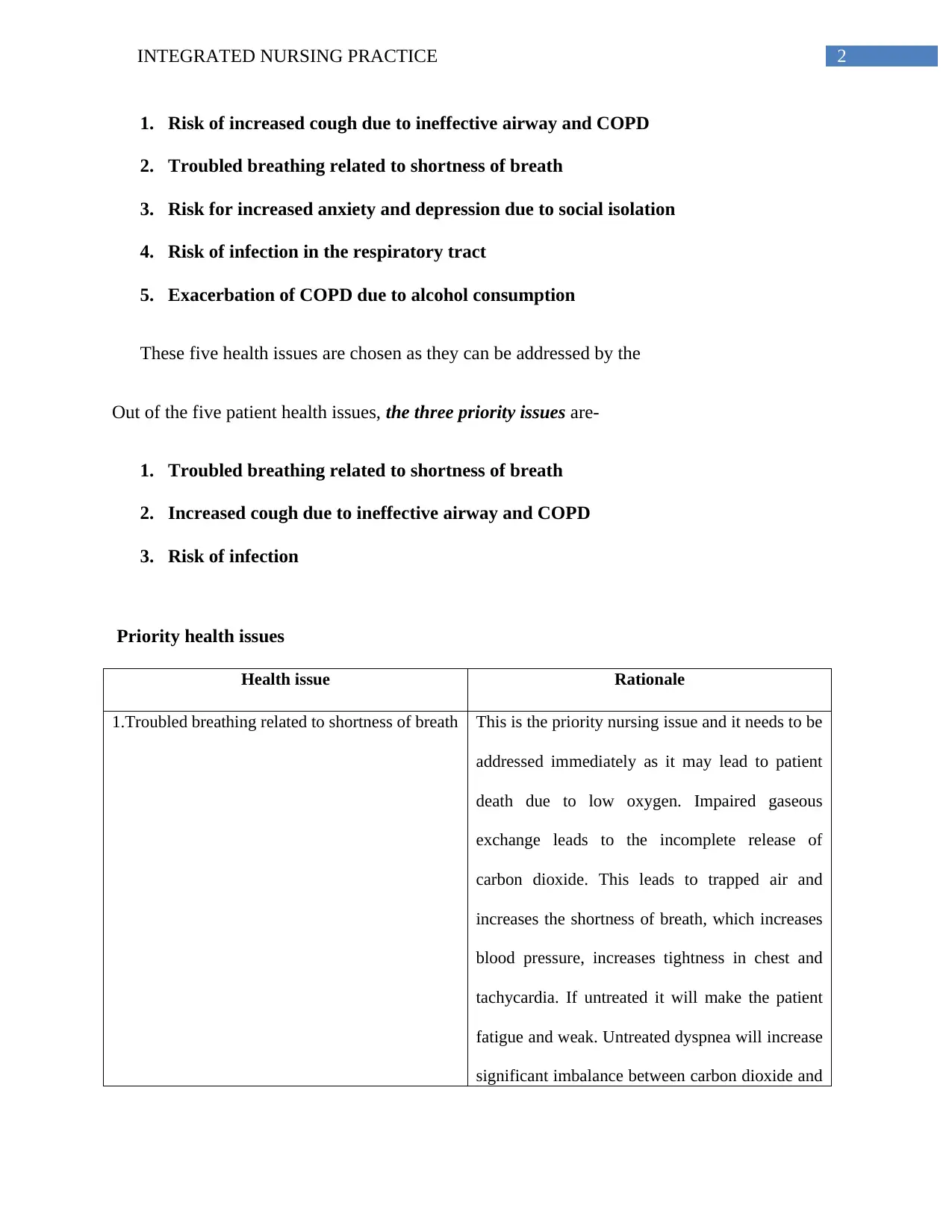
2INTEGRATED NURSING PRACTICE
1. Risk of increased cough due to ineffective airway and COPD
2. Troubled breathing related to shortness of breath
3. Risk for increased anxiety and depression due to social isolation
4. Risk of infection in the respiratory tract
5. Exacerbation of COPD due to alcohol consumption
These five health issues are chosen as they can be addressed by the
Out of the five patient health issues, the three priority issues are-
1. Troubled breathing related to shortness of breath
2. Increased cough due to ineffective airway and COPD
3. Risk of infection
Priority health issues
Health issue Rationale
1.Troubled breathing related to shortness of breath This is the priority nursing issue and it needs to be
addressed immediately as it may lead to patient
death due to low oxygen. Impaired gaseous
exchange leads to the incomplete release of
carbon dioxide. This leads to trapped air and
increases the shortness of breath, which increases
blood pressure, increases tightness in chest and
tachycardia. If untreated it will make the patient
fatigue and weak. Untreated dyspnea will increase
significant imbalance between carbon dioxide and
1. Risk of increased cough due to ineffective airway and COPD
2. Troubled breathing related to shortness of breath
3. Risk for increased anxiety and depression due to social isolation
4. Risk of infection in the respiratory tract
5. Exacerbation of COPD due to alcohol consumption
These five health issues are chosen as they can be addressed by the
Out of the five patient health issues, the three priority issues are-
1. Troubled breathing related to shortness of breath
2. Increased cough due to ineffective airway and COPD
3. Risk of infection
Priority health issues
Health issue Rationale
1.Troubled breathing related to shortness of breath This is the priority nursing issue and it needs to be
addressed immediately as it may lead to patient
death due to low oxygen. Impaired gaseous
exchange leads to the incomplete release of
carbon dioxide. This leads to trapped air and
increases the shortness of breath, which increases
blood pressure, increases tightness in chest and
tachycardia. If untreated it will make the patient
fatigue and weak. Untreated dyspnea will increase
significant imbalance between carbon dioxide and
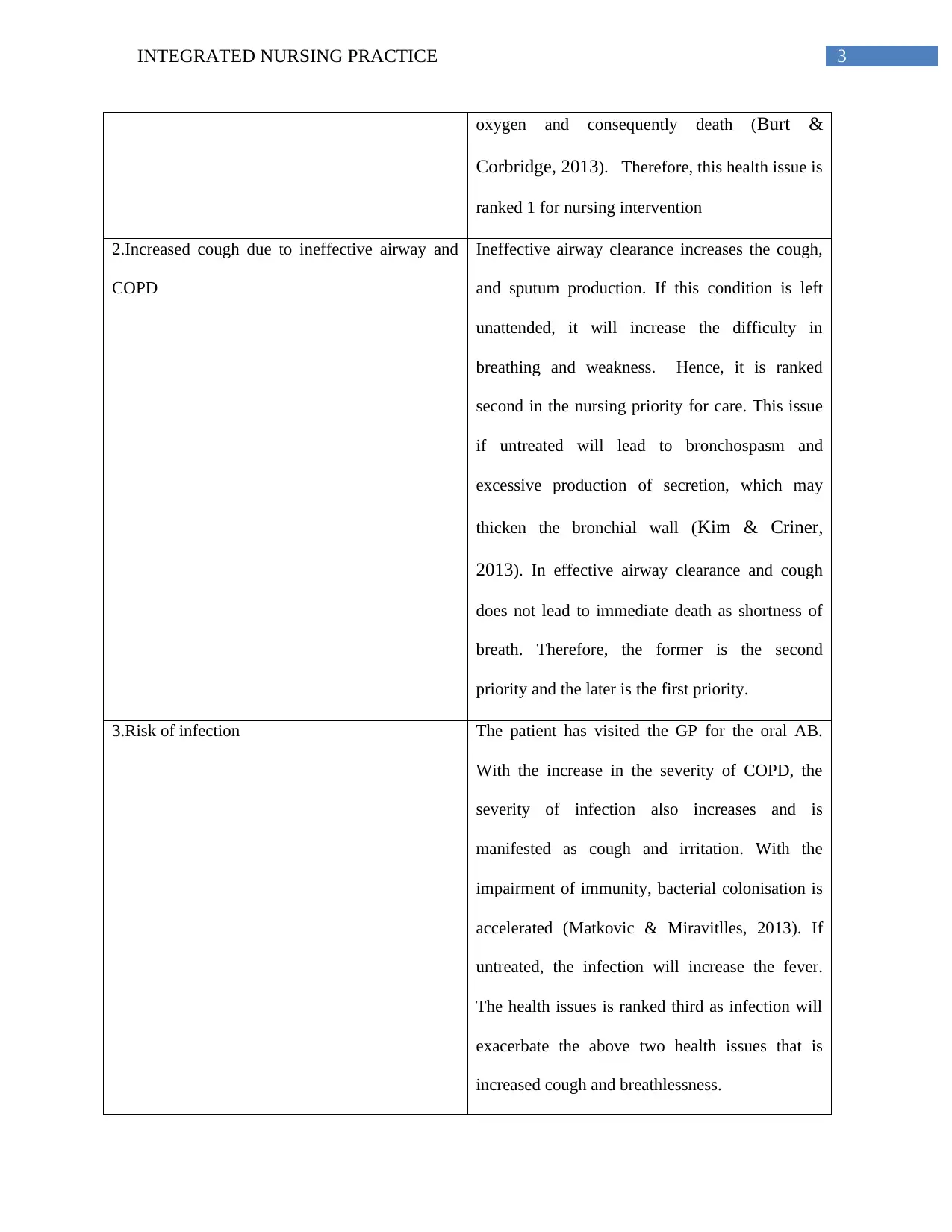
3INTEGRATED NURSING PRACTICE
oxygen and consequently death (Burt &
Corbridge, 2013). Therefore, this health issue is
ranked 1 for nursing intervention
2.Increased cough due to ineffective airway and
COPD
Ineffective airway clearance increases the cough,
and sputum production. If this condition is left
unattended, it will increase the difficulty in
breathing and weakness. Hence, it is ranked
second in the nursing priority for care. This issue
if untreated will lead to bronchospasm and
excessive production of secretion, which may
thicken the bronchial wall (Kim & Criner,
2013). In effective airway clearance and cough
does not lead to immediate death as shortness of
breath. Therefore, the former is the second
priority and the later is the first priority.
3.Risk of infection The patient has visited the GP for the oral AB.
With the increase in the severity of COPD, the
severity of infection also increases and is
manifested as cough and irritation. With the
impairment of immunity, bacterial colonisation is
accelerated (Matkovic & Miravitlles, 2013). If
untreated, the infection will increase the fever.
The health issues is ranked third as infection will
exacerbate the above two health issues that is
increased cough and breathlessness.
oxygen and consequently death (Burt &
Corbridge, 2013). Therefore, this health issue is
ranked 1 for nursing intervention
2.Increased cough due to ineffective airway and
COPD
Ineffective airway clearance increases the cough,
and sputum production. If this condition is left
unattended, it will increase the difficulty in
breathing and weakness. Hence, it is ranked
second in the nursing priority for care. This issue
if untreated will lead to bronchospasm and
excessive production of secretion, which may
thicken the bronchial wall (Kim & Criner,
2013). In effective airway clearance and cough
does not lead to immediate death as shortness of
breath. Therefore, the former is the second
priority and the later is the first priority.
3.Risk of infection The patient has visited the GP for the oral AB.
With the increase in the severity of COPD, the
severity of infection also increases and is
manifested as cough and irritation. With the
impairment of immunity, bacterial colonisation is
accelerated (Matkovic & Miravitlles, 2013). If
untreated, the infection will increase the fever.
The health issues is ranked third as infection will
exacerbate the above two health issues that is
increased cough and breathlessness.
Secure Best Marks with AI Grader
Need help grading? Try our AI Grader for instant feedback on your assignments.
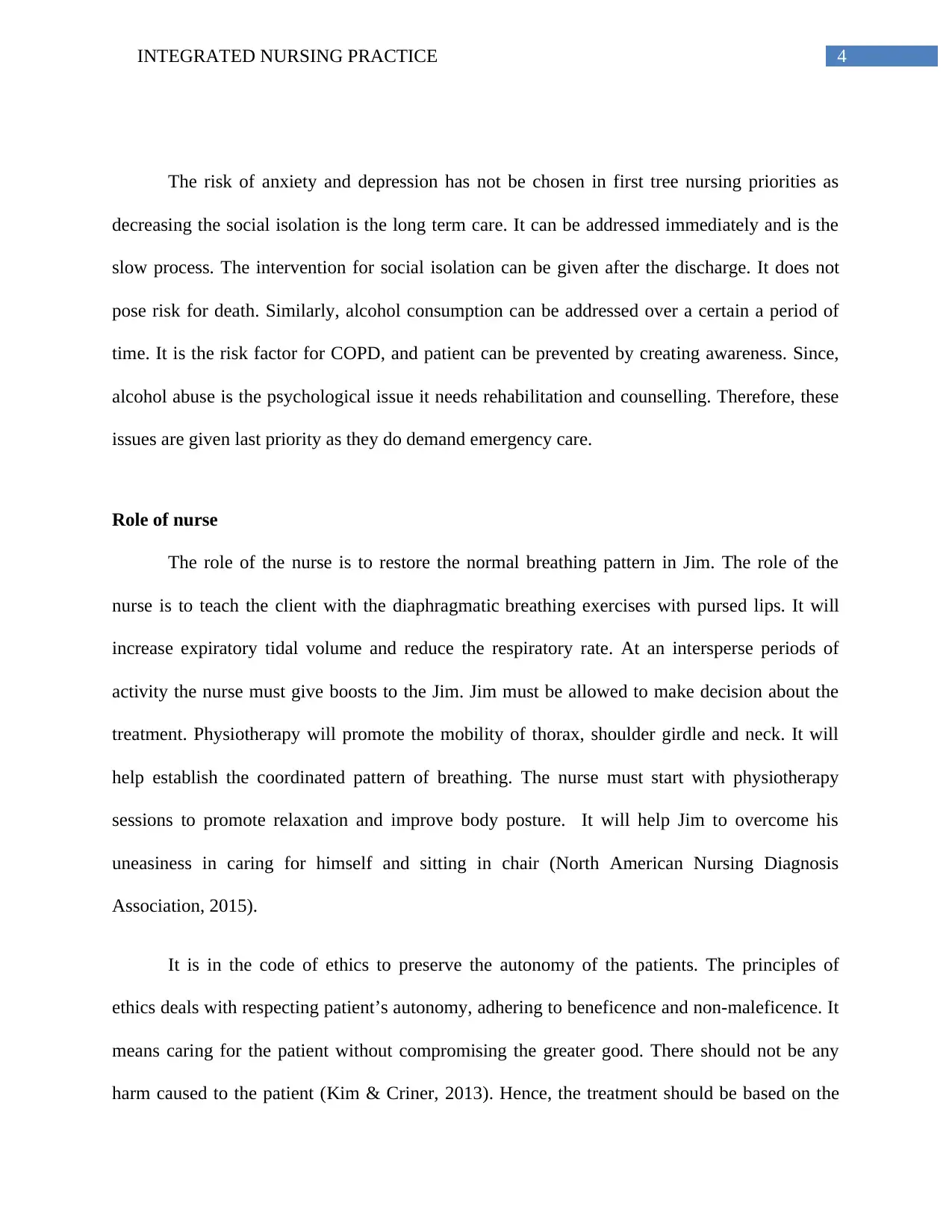
4INTEGRATED NURSING PRACTICE
The risk of anxiety and depression has not be chosen in first tree nursing priorities as
decreasing the social isolation is the long term care. It can be addressed immediately and is the
slow process. The intervention for social isolation can be given after the discharge. It does not
pose risk for death. Similarly, alcohol consumption can be addressed over a certain a period of
time. It is the risk factor for COPD, and patient can be prevented by creating awareness. Since,
alcohol abuse is the psychological issue it needs rehabilitation and counselling. Therefore, these
issues are given last priority as they do demand emergency care.
Role of nurse
The role of the nurse is to restore the normal breathing pattern in Jim. The role of the
nurse is to teach the client with the diaphragmatic breathing exercises with pursed lips. It will
increase expiratory tidal volume and reduce the respiratory rate. At an intersperse periods of
activity the nurse must give boosts to the Jim. Jim must be allowed to make decision about the
treatment. Physiotherapy will promote the mobility of thorax, shoulder girdle and neck. It will
help establish the coordinated pattern of breathing. The nurse must start with physiotherapy
sessions to promote relaxation and improve body posture. It will help Jim to overcome his
uneasiness in caring for himself and sitting in chair (North American Nursing Diagnosis
Association, 2015).
It is in the code of ethics to preserve the autonomy of the patients. The principles of
ethics deals with respecting patient’s autonomy, adhering to beneficence and non-maleficence. It
means caring for the patient without compromising the greater good. There should not be any
harm caused to the patient (Kim & Criner, 2013). Hence, the treatment should be based on the
The risk of anxiety and depression has not be chosen in first tree nursing priorities as
decreasing the social isolation is the long term care. It can be addressed immediately and is the
slow process. The intervention for social isolation can be given after the discharge. It does not
pose risk for death. Similarly, alcohol consumption can be addressed over a certain a period of
time. It is the risk factor for COPD, and patient can be prevented by creating awareness. Since,
alcohol abuse is the psychological issue it needs rehabilitation and counselling. Therefore, these
issues are given last priority as they do demand emergency care.
Role of nurse
The role of the nurse is to restore the normal breathing pattern in Jim. The role of the
nurse is to teach the client with the diaphragmatic breathing exercises with pursed lips. It will
increase expiratory tidal volume and reduce the respiratory rate. At an intersperse periods of
activity the nurse must give boosts to the Jim. Jim must be allowed to make decision about the
treatment. Physiotherapy will promote the mobility of thorax, shoulder girdle and neck. It will
help establish the coordinated pattern of breathing. The nurse must start with physiotherapy
sessions to promote relaxation and improve body posture. It will help Jim to overcome his
uneasiness in caring for himself and sitting in chair (North American Nursing Diagnosis
Association, 2015).
It is in the code of ethics to preserve the autonomy of the patients. The principles of
ethics deals with respecting patient’s autonomy, adhering to beneficence and non-maleficence. It
means caring for the patient without compromising the greater good. There should not be any
harm caused to the patient (Kim & Criner, 2013). Hence, the treatment should be based on the
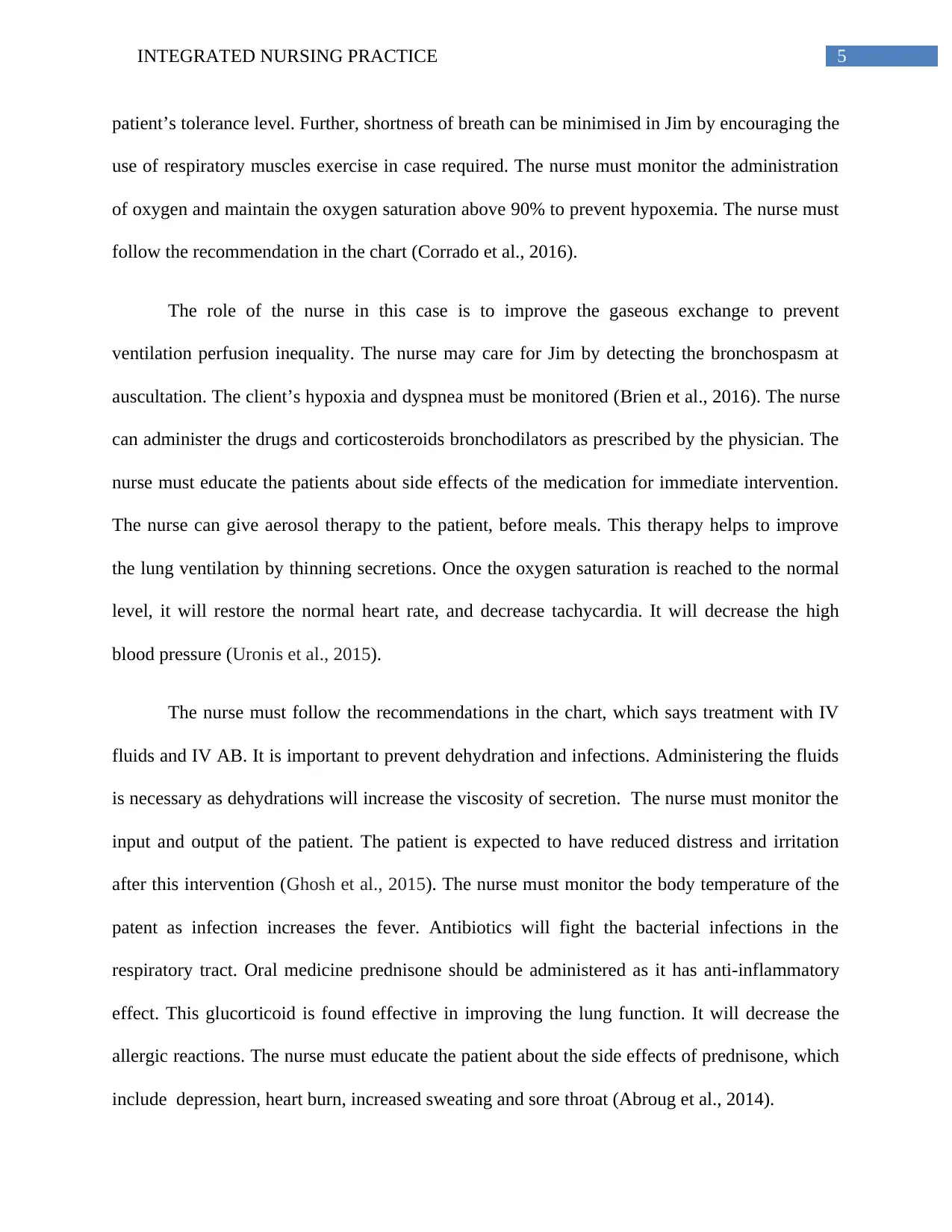
5INTEGRATED NURSING PRACTICE
patient’s tolerance level. Further, shortness of breath can be minimised in Jim by encouraging the
use of respiratory muscles exercise in case required. The nurse must monitor the administration
of oxygen and maintain the oxygen saturation above 90% to prevent hypoxemia. The nurse must
follow the recommendation in the chart (Corrado et al., 2016).
The role of the nurse in this case is to improve the gaseous exchange to prevent
ventilation perfusion inequality. The nurse may care for Jim by detecting the bronchospasm at
auscultation. The client’s hypoxia and dyspnea must be monitored (Brien et al., 2016). The nurse
can administer the drugs and corticosteroids bronchodilators as prescribed by the physician. The
nurse must educate the patients about side effects of the medication for immediate intervention.
The nurse can give aerosol therapy to the patient, before meals. This therapy helps to improve
the lung ventilation by thinning secretions. Once the oxygen saturation is reached to the normal
level, it will restore the normal heart rate, and decrease tachycardia. It will decrease the high
blood pressure (Uronis et al., 2015).
The nurse must follow the recommendations in the chart, which says treatment with IV
fluids and IV AB. It is important to prevent dehydration and infections. Administering the fluids
is necessary as dehydrations will increase the viscosity of secretion. The nurse must monitor the
input and output of the patient. The patient is expected to have reduced distress and irritation
after this intervention (Ghosh et al., 2015). The nurse must monitor the body temperature of the
patent as infection increases the fever. Antibiotics will fight the bacterial infections in the
respiratory tract. Oral medicine prednisone should be administered as it has anti-inflammatory
effect. This glucorticoid is found effective in improving the lung function. It will decrease the
allergic reactions. The nurse must educate the patient about the side effects of prednisone, which
include depression, heart burn, increased sweating and sore throat (Abroug et al., 2014).
patient’s tolerance level. Further, shortness of breath can be minimised in Jim by encouraging the
use of respiratory muscles exercise in case required. The nurse must monitor the administration
of oxygen and maintain the oxygen saturation above 90% to prevent hypoxemia. The nurse must
follow the recommendation in the chart (Corrado et al., 2016).
The role of the nurse in this case is to improve the gaseous exchange to prevent
ventilation perfusion inequality. The nurse may care for Jim by detecting the bronchospasm at
auscultation. The client’s hypoxia and dyspnea must be monitored (Brien et al., 2016). The nurse
can administer the drugs and corticosteroids bronchodilators as prescribed by the physician. The
nurse must educate the patients about side effects of the medication for immediate intervention.
The nurse can give aerosol therapy to the patient, before meals. This therapy helps to improve
the lung ventilation by thinning secretions. Once the oxygen saturation is reached to the normal
level, it will restore the normal heart rate, and decrease tachycardia. It will decrease the high
blood pressure (Uronis et al., 2015).
The nurse must follow the recommendations in the chart, which says treatment with IV
fluids and IV AB. It is important to prevent dehydration and infections. Administering the fluids
is necessary as dehydrations will increase the viscosity of secretion. The nurse must monitor the
input and output of the patient. The patient is expected to have reduced distress and irritation
after this intervention (Ghosh et al., 2015). The nurse must monitor the body temperature of the
patent as infection increases the fever. Antibiotics will fight the bacterial infections in the
respiratory tract. Oral medicine prednisone should be administered as it has anti-inflammatory
effect. This glucorticoid is found effective in improving the lung function. It will decrease the
allergic reactions. The nurse must educate the patient about the side effects of prednisone, which
include depression, heart burn, increased sweating and sore throat (Abroug et al., 2014).

6INTEGRATED NURSING PRACTICE
The nurse must monitor the patient’s body temperature to reduce fever. Pulmonary
infection can be determined by character, colour, and odour of sputum. The patient must be
taught to frequently change the position and increase fluid intake (Jellington et al., 2016). These
interventions together with the breathing exercises and effective cough will promote
mobilisation. It will promote the expectoration of secretions and decrease in infection. It is
necessary to maintain the balance between the activity and rest as it will promote quick healing.
It will increase resistance to infection. The nurse can assist Jim in having balanced diet as
appropriate for age. Malnutrition may decrease resistance to infection (Atkins et al., 2017).
For fast relief, the nurse must implement patient centred care. This care refers to
respecting the client’s beliefs, values and preferred needs. The nurse can involve the family
members to decrease the feeling of powerlessness and vulnerability. Involving Jim’s community
members will enhance the emotional support and reduce the loneliness. It will help to build the
therapeutic relationship between Jim and nurse is based on understanding the patients and on
mutual trust between care providers and users (Disler et al., 2013).
Conclusion
In the given assignment, the case study of Jim is undertaken for determining the five
patient health issues and three of them has been ranked as highest priory issue. The prioritisation
is based on critical thinking of the presenting conditions and evidence. Based on the priority
health issues the nursing role pertaining to this case is discussed.
The nurse must monitor the patient’s body temperature to reduce fever. Pulmonary
infection can be determined by character, colour, and odour of sputum. The patient must be
taught to frequently change the position and increase fluid intake (Jellington et al., 2016). These
interventions together with the breathing exercises and effective cough will promote
mobilisation. It will promote the expectoration of secretions and decrease in infection. It is
necessary to maintain the balance between the activity and rest as it will promote quick healing.
It will increase resistance to infection. The nurse can assist Jim in having balanced diet as
appropriate for age. Malnutrition may decrease resistance to infection (Atkins et al., 2017).
For fast relief, the nurse must implement patient centred care. This care refers to
respecting the client’s beliefs, values and preferred needs. The nurse can involve the family
members to decrease the feeling of powerlessness and vulnerability. Involving Jim’s community
members will enhance the emotional support and reduce the loneliness. It will help to build the
therapeutic relationship between Jim and nurse is based on understanding the patients and on
mutual trust between care providers and users (Disler et al., 2013).
Conclusion
In the given assignment, the case study of Jim is undertaken for determining the five
patient health issues and three of them has been ranked as highest priory issue. The prioritisation
is based on critical thinking of the presenting conditions and evidence. Based on the priority
health issues the nursing role pertaining to this case is discussed.
Paraphrase This Document
Need a fresh take? Get an instant paraphrase of this document with our AI Paraphraser
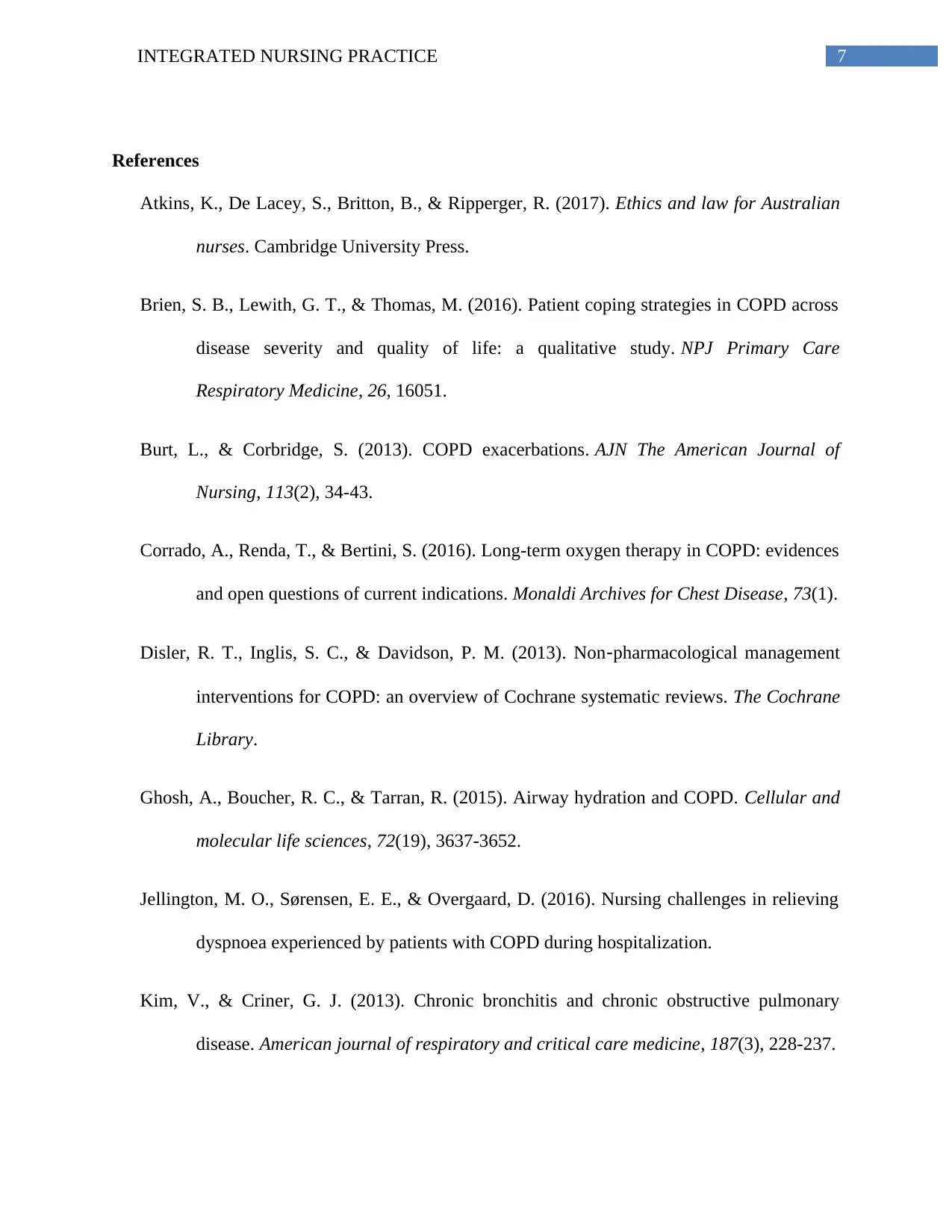
7INTEGRATED NURSING PRACTICE
References
Atkins, K., De Lacey, S., Britton, B., & Ripperger, R. (2017). Ethics and law for Australian
nurses. Cambridge University Press.
Brien, S. B., Lewith, G. T., & Thomas, M. (2016). Patient coping strategies in COPD across
disease severity and quality of life: a qualitative study. NPJ Primary Care
Respiratory Medicine, 26, 16051.
Burt, L., & Corbridge, S. (2013). COPD exacerbations. AJN The American Journal of
Nursing, 113(2), 34-43.
Corrado, A., Renda, T., & Bertini, S. (2016). Long-term oxygen therapy in COPD: evidences
and open questions of current indications. Monaldi Archives for Chest Disease, 73(1).
Disler, R. T., Inglis, S. C., & Davidson, P. M. (2013). Non‐pharmacological management
interventions for COPD: an overview of Cochrane systematic reviews. The Cochrane
Library.
Ghosh, A., Boucher, R. C., & Tarran, R. (2015). Airway hydration and COPD. Cellular and
molecular life sciences, 72(19), 3637-3652.
Jellington, M. O., Sørensen, E. E., & Overgaard, D. (2016). Nursing challenges in relieving
dyspnoea experienced by patients with COPD during hospitalization.
Kim, V., & Criner, G. J. (2013). Chronic bronchitis and chronic obstructive pulmonary
disease. American journal of respiratory and critical care medicine, 187(3), 228-237.
References
Atkins, K., De Lacey, S., Britton, B., & Ripperger, R. (2017). Ethics and law for Australian
nurses. Cambridge University Press.
Brien, S. B., Lewith, G. T., & Thomas, M. (2016). Patient coping strategies in COPD across
disease severity and quality of life: a qualitative study. NPJ Primary Care
Respiratory Medicine, 26, 16051.
Burt, L., & Corbridge, S. (2013). COPD exacerbations. AJN The American Journal of
Nursing, 113(2), 34-43.
Corrado, A., Renda, T., & Bertini, S. (2016). Long-term oxygen therapy in COPD: evidences
and open questions of current indications. Monaldi Archives for Chest Disease, 73(1).
Disler, R. T., Inglis, S. C., & Davidson, P. M. (2013). Non‐pharmacological management
interventions for COPD: an overview of Cochrane systematic reviews. The Cochrane
Library.
Ghosh, A., Boucher, R. C., & Tarran, R. (2015). Airway hydration and COPD. Cellular and
molecular life sciences, 72(19), 3637-3652.
Jellington, M. O., Sørensen, E. E., & Overgaard, D. (2016). Nursing challenges in relieving
dyspnoea experienced by patients with COPD during hospitalization.
Kim, V., & Criner, G. J. (2013). Chronic bronchitis and chronic obstructive pulmonary
disease. American journal of respiratory and critical care medicine, 187(3), 228-237.
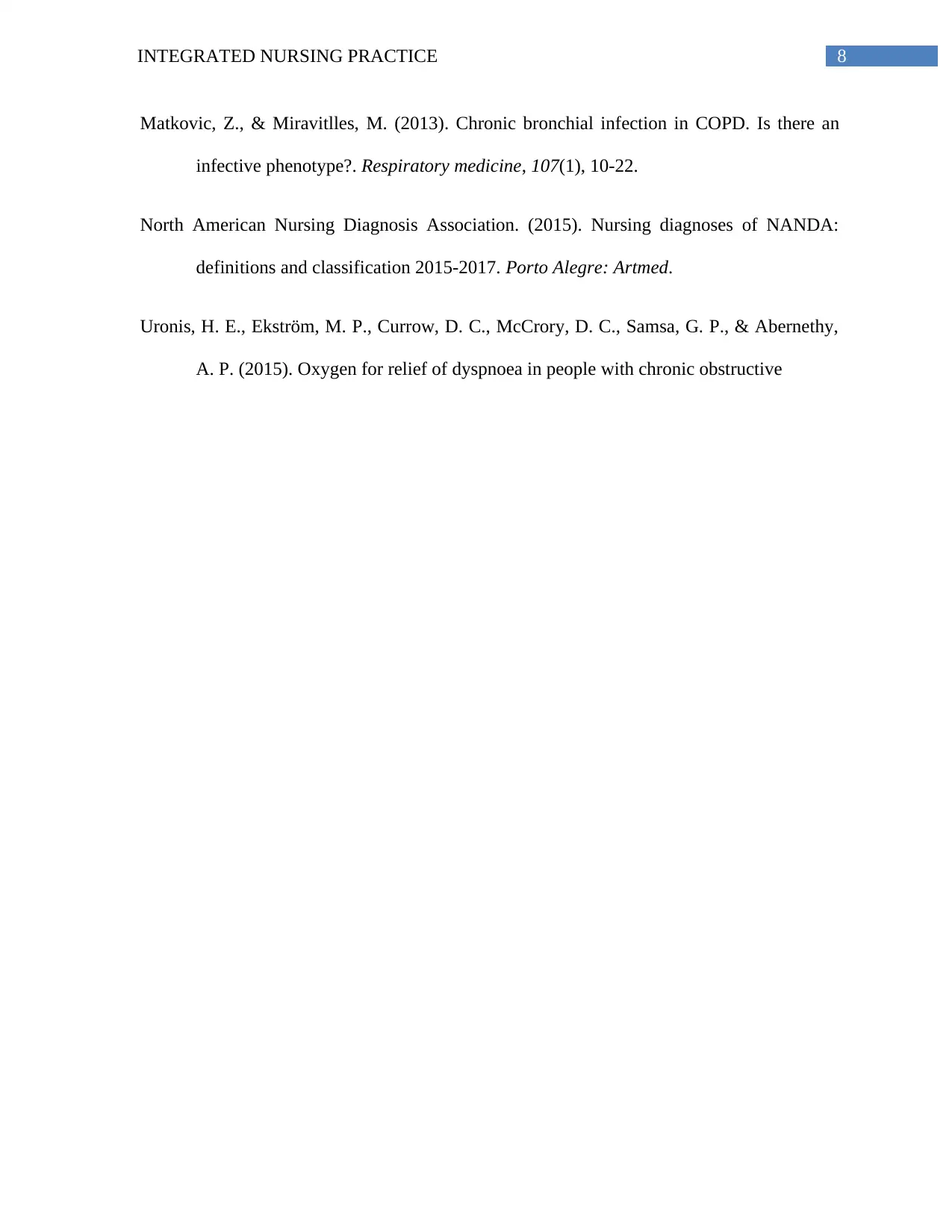
8INTEGRATED NURSING PRACTICE
Matkovic, Z., & Miravitlles, M. (2013). Chronic bronchial infection in COPD. Is there an
infective phenotype?. Respiratory medicine, 107(1), 10-22.
North American Nursing Diagnosis Association. (2015). Nursing diagnoses of NANDA:
definitions and classification 2015-2017. Porto Alegre: Artmed.
Uronis, H. E., Ekström, M. P., Currow, D. C., McCrory, D. C., Samsa, G. P., & Abernethy,
A. P. (2015). Oxygen for relief of dyspnoea in people with chronic obstructive
Matkovic, Z., & Miravitlles, M. (2013). Chronic bronchial infection in COPD. Is there an
infective phenotype?. Respiratory medicine, 107(1), 10-22.
North American Nursing Diagnosis Association. (2015). Nursing diagnoses of NANDA:
definitions and classification 2015-2017. Porto Alegre: Artmed.
Uronis, H. E., Ekström, M. P., Currow, D. C., McCrory, D. C., Samsa, G. P., & Abernethy,
A. P. (2015). Oxygen for relief of dyspnoea in people with chronic obstructive
1 out of 9
Related Documents
Your All-in-One AI-Powered Toolkit for Academic Success.
+13062052269
info@desklib.com
Available 24*7 on WhatsApp / Email
![[object Object]](/_next/static/media/star-bottom.7253800d.svg)
Unlock your academic potential
© 2024 | Zucol Services PVT LTD | All rights reserved.




